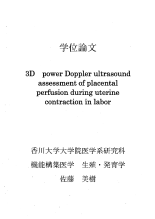3D power Doppler ultrasound assessment of placental perfusion during uterine contraction in labor
この論文にアクセスする
著者
書誌事項
- タイトル
-
3D power Doppler ultrasound assessment of placental perfusion during uterine contraction in labor
- 著者名
-
佐藤, 美樹
- 学位授与大学
-
香川大学
- 取得学位
-
博士(医学)
- 学位授与番号
-
甲第664号
- 学位授与年月日
-
2017-03-24
注記・抄録
IntroductionTo assess placental perfusion during spontaneous or induced uterine contraction in labor at term using placental vascular sonobiopsy (PVS) by 3D power Doppler ultrasound with the VOCAL imaging analysis program.
MethodPVS was performed in 50 normal pregnancies (32 in spontaneous labor group [SLG], and 18 in induced labor group with oxytocin or prostaglandin F2α [ILG]) at 37–41 weeks of gestation to assess placental perfusion during uterine contraction in labor. Only pregnancies with an entirely visualized anterior placenta were included in the study. Data acquisition was performed before, during (at the peak of contraction), and after uterine contraction. 3D power Doppler indices such as the vascularization index (VI), flow index (FI), and vascularization flow index (VFI) were calculated in each placenta.
ResultsThere were no abnormal fetal heart rate tracings during contraction in either group. VI and VFI values were significantly reduced during uterine contraction in both groups (SLG, −33.4% [−97.0–15.2%], and ILG, −49.6% [−78.2–−4.0%]), respectively (P < 0.001). The FI value in the ILG group was significantly lower during uterine contraction (P = 0.035), whereas it did not change during uterine contraction in the SLG group. After uterine contraction, all vascular indices returned almost to the same level as that before uterine contraction. However, the FI value in ILG (−8.6%, [−19.7–16.0%]) was significantly lower than that in SLG (2.4%, [−13.4–38.1%]) after uterine contraction (P < 0.05). All 3D power Doppler indices (VI, FI, and VFI) during uterine contraction (at the peak of contraction) showed a correlation greater than 0.7, with good intra- and inter-observer agreements.
DiscussionOur findings suggest that uterine contraction in both spontaneous and induced labors causes a significant reduction in placental perfusion. Reduced placental blood flow in induced uterine contraction has a tendency to be marked compared with that in spontaneous uterine contraction. To the best of our knowledge, this is the first study on the non-invasive assessment of placental perfusion during uterine contraction in labor using 3D power Doppler ultrasound. However, the data and their interpretation in the present study should be taken with some degree of caution because of the small number of subjects studied. Further studies involving a larger sample size are needed to assess placental perfusion and vascularity using PVS during normal and abnormal uterine contractions in normal and high-risk pregnancies.
Introduction To assess placental perfusion during spontaneous or induced uterine contraction in labor at term using placental vascular sonobiopsy (PVS) by 3D power Doppler ultrasound with the VOCAL imaging analysis program.
Method PVS was performed in 50 normal pregnancies (32 in spontaneous labor group [SLG], and 18 in induced labor group with oxytocin or prostaglandin F2α [ILG]) at 37–41 weeks of gestation to assess placental perfusion during uterine contraction in labor. Only pregnancies with an entirely visualized anterior placenta were included in the study. Data acquisition was performed before, during (at the peak of contraction), and after uterine contraction. 3D power Doppler indices such as the vascularization index (VI), flow index (FI), and vascularization flow index (VFI) were calculated in each placenta.
Results There were no abnormal fetal heart rate tracings during contraction in either group. VI and VFI values were significantly reduced during uterine contraction in both groups (SLG, −33.4% [−97.0–15.2%], and ILG, −49.6% [−78.2–−4.0%]), respectively (P < 0.001). The FI value in the ILG group was significantly lower during uterine contraction (P = 0.035), whereas it did not change during uterine contraction in the SLG group. After uterine contraction, all vascular indices returned almost to the same level as that before uterine contraction. However, the FI value in ILG (−8.6%, [−19.7–16.0%]) was significantly lower than that in SLG (2.4%, [−13.4–38.1%]) after uterine contraction (P < 0.05). All 3D power Doppler indices (VI, FI, and VFI) during uterine contraction (at the peak of contraction) showed a correlation greater than 0.7, with good intra- and inter-observer agreements.
Discussion Our findings suggest that uterine contraction in both spontaneous and induced labors causes a significant reduction in placental perfusion. Reduced placental blood flow in induced uterine contraction has a tendency to be marked compared with that in spontaneous uterine contraction. To the best of our knowledge, this is the first study on the non-invasive assessment of placental perfusion during uterine contraction in labor using 3D power Doppler ultrasound. However, the data and their interpretation in the present study should be taken with some degree of caution because of the small number of subjects studied. Further studies involving a larger sample size are needed to assess placental perfusion and vascularity using PVS during normal and abnormal uterine contractions in normal and high-risk pregnancies.

